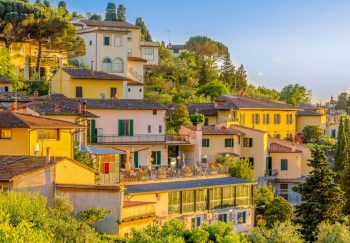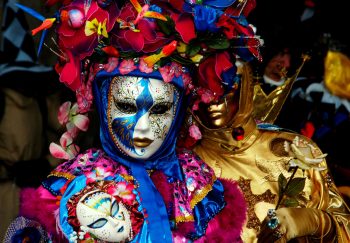St. Mark’s Square was once known as “The drawing room” in Europe. It takes only one visit to fully grasp why. The largest piazza in Venice, both grandiose yet intimate, rich with embellishments but utterly refined, and bustling with people, is truly one of Italy’s most stunning.
It radiates from the Basilica of St. Mark like much of Venice. Its most famous ornaments can be traced back the 13th century Siege of Constantinople, which brought Venice many of its richest treasures in the form plunder.
You can visit Venice and take in the sights, such as the Basilica, Doge’s Palace, and Clock Tower. Or you can just relax in a cafe and watch the people pass by.
What can you see in St. Mark’s Square
The Basilica di San Marco
Two enterprising Venetians took the remains of St. Mark and hidden them in salted pork barrels. The Muslims refused to search them so the city needed a home for them. Thus, St. Mark’s Cathedral was created. It was both the spiritual center of Venice as well as the private chapel of the Doge. As Venice expanded her maritime empire, its size and splendor grew.
It was known as “Chiesa d’Oro”, or “Church of Gold”, by the 11th century. In the 13th century, it received much of the plunder (gold and jewels, plus even marble columns) from Constantinople’s 4th crusade pillage.
It is today regarded as one of the finest examples of Italo–Byzantine architecture. Constantinople also wants its beautiful things back. This building is unique in Italy because of its influence on Venice’s architecture by the Byzantine Empire and other Eastern cultures.
Continue reading: 6 Amazing Facts about St. Mark’s Basilica
The Horses of St. Mark
Four bronze horses, once a part of Constantinople’s hippodrome, are perhaps the most well-known pieces of plunder that have been returned from Constantinople. Although their age and provenance are not known, they are believed to have been made in the 4th century BC by a Greek sculptor. They were placed on the terrace of St. Mark’s Basilica, where they remained until Napoleon looted Venice in 1797.
In 1815, the Venetians returned their horses but moved their originals to St. Mark’s Museum to keep them from weathering. The exact replicas you see today on the church are exactly what you would expect. Interesting side note: The collars originally covered the heads of the horses in order to conceal the fact that they had been cut to fit into the ships that would transport them from Constantinople, Italy to Venice.
Find out more about St. Mark’s Basilica or the Doge’s Palace. See our Venice experiences of St. Mark’s Basilica and the Doge’s Palace. Or, for a VIP experience, visit St. After hours, Mark’s Basilica is closed to the public.
The Doge’s Palace
Without a well-oiled government apparatus, you can’t manage a maritime empire that spans across the entire Mediterranean Sea from a small lagoon for around 400 years. This apparatus had its home in the Doge’s Palace. It served as a residence, courtroom, and administrative building for a nation that had no land.
They kept records from here and made many of the important decisions that governed trade and commerce in the Mediterranean. It contained the executive, legislative and judicial branches all in one building.
The building was first constructed in the tenth-century and then expanded as the Republic grew. It evolved with Venetian society, until it became a museum in 1923. It is an amazing trip through the history and evolution of the empire as you walk through its many rooms and passageways.
St. Mark’s Bell Tower
The Bell Tower, also known as St. Mark’s Campanile, was originally built in 9th century to watch over the docks. However, it didn’t reach its final form until after the 16th century. It wasn’t easy sailing, however.
The tower was notorious for catching lightning and setting fire to himself. The damage continued to mount over the years, and the tower finally collapsed in 1902. Amazingly, the cat who was caring for the tower was the only one to be hurt. The tower has not suffered any further damage since it was rebuilt in 1912. Thousands of people climb the tower each year. However, it is now closed to the lightning.
Caffe Florian
Coffee houses have always been places where people of all walks of life can meet, share ideas and socialize. Caffe Florian is the oldest coffeehouse still in operation and has hosted some the most important meetings of minds in history.
This St. Mark’s Square institution was once a popular hangout for Goethe, Cassanova and Byron as well as Proust and Charles Dickens. This cafe is not just a success because of the company it employs. The Venetians brought coffee to Europe from North Africa. Venice was home to the first European coffee shops. They still make the best espresso you can find anywhere.
Tips to Visit St. Mark’s Square
Opening Times
St. Mark’s Square can be accessed free of charge 24 hours a days as a public piazza.
The hours of operation at St. Mark’s Basilica vary depending on the season. It is open from the end of Easter through November, and Sundays and holidays from 9:30am to 5;15pm on Monday through Saturday. Last entry at 4.45pm. The hours remain the same from November to the end of Easter, which changes each year. Sundays and holidays are 2:00pm to 4:00pm.
You can find more information on the website.
The Bell Tower’s hours of operation change depending on the season. In October, it is open from 9:00am until 7:00pm. It’s open between November and March/April (Easter), from 9:30am until 3:45pm. It’s open between 9:00am and 7:00pm from March/April (Easter), through June. It’s open daily from 9:00am to 9:00pm, July through September.
The Doge’s Palace will be open daily from 10.00am to 6.00pm. Last entry is at 5.00pm. For any updates in their opening hours, please visit their website.
It is usually open during the low season and high season. The Palace is open daily from April 1st through October 31st, with the last entry at 6:45pm. The palace is open between November 1st and March 31st from 8:30am until 5:30pm, with the last entry at 4:30pm. The palace closes on December 25th, and January 1st.
Rules
It is important to remember that you may encounter acqua alt during off-season visits, particularly in winter. flooding. When the water level in the lagoon rises and floods Venice, it is caused by a combination southerly winds, high seas and the southerly-blowing wind.
The storm drains from the Piazza San Marco run directly into the lagoon. This means that water can return to the surface at times of or acqua alta. You’ll be anywhere from ankle-to-knee deep in water.
The Venice flood barriers have been tested. They protected the city against high tides up to 3 metres. They will be functional by the end of 2021.
These weather conditions will cause elevated wooden walkways to be constructed along the main thoroughfare. However, if you are able to bring sturdy rubber boots they will keep your feet safe.
Please dress appropriately if you are planning to visit St. Mark’s Basilica. Both men and women need to cover their shoulders, knees, and ankles.
Continue reading: Venice’s Acqua Alta
The Best Times to Visit St. Mark’s Square
You must weigh crowds and weather when visiting St. Mark’s Square. Venice’s winter can be cold and damp. Summers can be hot, and packed full of people. Both spring and autumn have similar weather, but they are packed.
There will always be a lot of people in St. Mark’s Square. It is best to get up at dawn to make it less crowded. A sunrise walk in Venice, even in summer, is a great way to see the city almost empty.











